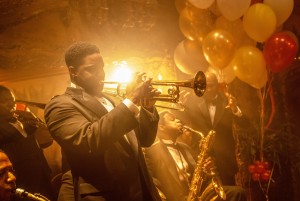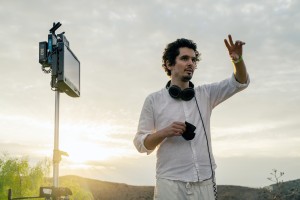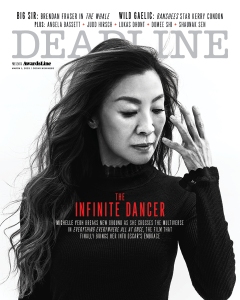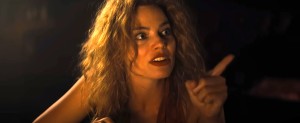Oscar-winning composer Justin Hurwitz has found himself back in the awards race this season, having garnered both a Golden Globe win and an Oscar nomination for his lavish Babylon score. Creating music that complemented the decadence and destructive glamor of 1920s Hollywood found in Damien Chazelle’s Babylon required a lot of experimentation. From using “kazoos and slide whistles” to “wooden floorboards” and multicultural percussionists amongst other unique instruments, Hurwitz and his 98-piece orchestra managed to execute the larger-than-life sounds and eclectic mix of tunes throughout the score, especially that of soundtrack highlight “Voodoo Mama.” In the behind-the-scenes video featured above, Hurwitz provides an in-depth look at the rich and explosive ensemble of harmonies influenced by diverse and modern sounds. “Babylon mixes up a lot of influences,” he tells Deadline. “It has some jazz influences, rock ‘n’ roll, and contemporary dance music in the music. There’s a lot of Middle Eastern and Latin flavors, orchestral cues, and a lot of circus sounds in the score.”
Hurwitz talks more about his frequent collaboration with Chazelle, taking himself seriously as an artist, and crafting the perfect amount of cacophony for Babylon.
DEADLINE: How would you say your working relationship with Damien has changed throughout the years? Can you better anticipate a certain sound he wants before sending the track over, or is it still as collaborative as ever?
JUSTIN HURWITZ: I’ve definitely gotten better at knowing what he’s going to like and what he’s not going to like. That being said, it’s never been an easy process, and it’s still not. I go through so many ideas before we land on the right ones, and I get, “No, no, no. Maybe? No, no,” before I finally get the, “Ah, that’s the one. That’s really the keeper.” So, it’s got a little more efficient. I’m able to anticipate a little better, but I still go through so many, and I rely on him so much to edit me. I think everybody needs an editor, and Damien filters my bad ideas from my OK ideas, my good ideas and my great ideas. And I really do rely on him to guide me into my best work, and working alone can be a very grueling process.
We got offices next to each other in post-production, so we were with each other for an entire year on this movie. It was about a three-year project for me in total of working on it. But pre-production, I’m working from [home], and I’m sending things off, then we’re on set, and then we’re together for a whole year in post-production. It can be a very long and difficult process sometimes, but I know that once I finally get the thumbs up from Damien on any given cue or any given theme, I feel good. It’s really, really gratifying to get that because he’s a very tough judge of my work, but I embrace that, and I appreciate that.
Margot Robbie in Babylon.
Paramount Pictures/Everett Collection
DEADLINE: Do you both keep track of each other’s musical tastes throughout the years? Are you both swapping your Spotify accounts or suggesting songs that help you stay musically in tune with each other?
HURWITZ: No, not really. I think he would be disappointed with what I listened to because all I listen to is Top 40 in the car, and I love it. I love pop music. The closest we get to swapping music is when we’re getting going on a project; he’ll sometimes send me a playlist of things that have inspired him and that he’s thinking about. They’re usually not literal models. For example, in the case of First Man, he sent me a lot of ’90s grunge music. And obviously, our score wasn’t that, but the grunge gave him a certain kind of angst and a certain kind of pain that he wanted to feel in our score.
Likewise, the music he sent me for Babylon wasn’t really 1920s jazz or 1920s music. It was a lot of rock ‘n’ roll and modern dance music that gave us the kind of feelings he wanted to feel in this score. Of course, I approached it again with different instrumentation and in a different way, but the music still kind of had an essence that he wanted to try to capture.
DEADLINE: You and Damien have worked on many different jazz iterations in your filmographies together. Would you call yourself the definitive jazz expert now, or are you still finding things that are fresh about the genre?
HURWITZ: No, I have no jazz background. People assume that I’m a jazz person, and it’s not where I come from at all. I grew up playing classical piano and then appreciating pop music and other kinds of music, but jazz wasn’t my thing. It was really through Damien’s movies that I’ve developed the grammar for jazz. And it’s a certain kind of jazz; it’s a very kind of tonal jazz. I would say it’s sort of like, we combine many more genres and styles in this score. The first movie we did, Guy and Madeline on a Park Bench, the jazz was very much in the mold of jazz standards. Whiplash was kind of mid-century big band music. La La Land was, again, more traditional.
And Babylon mixes up a lot of other influences. So, it has some jazz influences, but as I said, there’s a lot of rock ‘n’ roll in the music. There’s a lot of contemporary dance music in the music. There’s just a lot of flavors we draw from. There’s a lot of Middle Eastern flavors and Latin flavors. There were orchestral cues. There are a lot of circus sounds in the score. We’re really kind of putting a lot of different things in a blender to create the world of Babylon.

Jovan Adepo and his ax in Babylon.
Scott Garfield/Paramount Pictures/Everett Collection
DEADLINE: What did your orchestral setup look like for Babylon? How many instruments are we talking about here?
HURWITZ: The orchestral cues were a 98-piece orchestra. The pieces of music that are either a jazz band, or like montage cues that use the same sound were: two trumpets, three saxes, two trombones, a tuba, a banjo or guitar, drums, a piano and then many, many layers of additional percussions. So, we had a group of African percussionists come in and add a lot of layers. We had a group of Latin percussionists come in and add a lot of layers. In the track “Voodoo Mama”, there are layers and layers of me slamming wood boards on the floor of my home. And there are layers of me doing kazoos and slide whistles in some of those tracks that are ostensibly band tracks, but there’s still a lot of layers and vocals. Not professional vocalists. But that was another thing we wanted to do; use our band guys, like our horn players and whatnot, and bring them into the studio another time to layer vocals over the tracks so that it wouldn’t sound too choral or professional. It would sound like the feeling of band members kind of vocalizing in the middle of songs.
In some ways, we were inspired by Cab Calloway and his band, how there were certain call and responses and certain vocalizations that would come from the band, the band members themselves, not from professional singers. So, that was one sort of inspiration. Also, we were, again, inspired by certain rock ‘n’ roll tracks when it comes to the way that the vocals would sort of fit in, and there could be a sort of wailing over the top of these tracks. So, there were a lot of influences and a lot of layers.
DEADLINE: Everyone has a different creative process; what helps you visualize the music before you create it? Also, what do you keep in mind while scoring?
HURWITZ: I do think very narratively about our scores. We love to establish themes and melodies that belong to certain characters or ideas and then keep calling them back in ways that make narrative sense. In Babylon, for example, we seed pretty much all of the melodies at that first party. And then we sometimes bring those melodies back in very disguised ways to score different scenes of the movie. For example, when they go into the Blockhouse later at the very end of the film, it’s this sort of really creepy set piece, and there’s a cue that is almost like a horror cue.
It’s these sort of male droning vocals that have this sort of Gregorian chant quality to them. But underneath that cue, kind of building tension in that cue are these pitched gongs and chimes that play a little motif that is the same riff as “Voodoo Mama”. So, we’re calling back basically one of the main pieces of music from that first party. And the narrative reason is because that big dance number is associated with Nellie, Margot Robbie’s character, at the beginning of the movie. And here we’re way off on this other storyline, and there’s all this danger. But Nellie’s kind of the stakes here. If this plan doesn’t work with the money and all this, Nellie’s going to be totally screwed.
She should be in our mind somewhere, even if it’s subconscious; she should be in the back of our mind, like, “This better work for Nellie’s sake.” So, we thought to bring back that piece of musical material, even in a very disguised form, and pretty much every single cue in this movie is calling back some other cue from an earlier time. So, I love those narrative connections, and I love to score that way. I mean, the music has to be a story, really.

Babylon director Damien Chazelle on set.
Scott Garfield/Paramount Pictures/Everett Collection
DEADLINE: In what ways do you relate to the Babylon idea of passion and destruction displayed in the film? When did you start taking yourself more seriously as an artist?
HURWITZ: By the time I was finishing high school, I knew I wanted to study composition, and I knew I wanted to study music with an eye toward scoring films. So, I already had a sense of what I wanted to do at that point. But it was really in college that I think I developed the kind of work ethic I have now. And that was really something that bonded me and Damien when we met freshman year [of college], and we became friends. We became actual roommates sophomore year. And we were living together; we were sharing a bedroom and a workspace, so we were just always with each other. And he was always working on screenplays, and I was always working on my music. And it was that year, sophomore year, that I think we really bonded over a shared philosophy of working hard and sacrificing and just kind of sharing our dreams with each other and also pushing each other sometimes to stay focused and to keep our eye on our craft and being as good at our craft as we dreamed of being. Damien’s made a lot of movies about the sacrifices it takes when you’re really passionate about what you do. And I would say that it’s one of those ideas that bonded us from the very beginning as people before it ever became a theme in his movies.
DEADLINE: Which character was easier or harder to create music for? Nellie has this more fun, unhinged quality about her, while Jack Conrad is a bit smoother, more classical, and Manny has a warm sound. How did you manage crafting their personalities in the music as well?
HURWITZ: I would say that the Jack sound was easier in the sense that we were drawing on wistful and romantic feelings; it’s a tone I’ve scored before. Whereas the Manny and Nellie theme was the most challenging to narrow in on. And we went around with so many ideas before we found the right tone for the Manny and Nellie relationship themes. And where we ended up was, it’s the sound of three pianos blended together. One of the pianos is just a very sort of pretty-sounding Steinway mid-size grand. The second piano is a small spinet piano that’s treated with tacks in the hammers to give it a twang. And then the piano is also de-tuned a fair amount, so it’s a little bit out of tune. And then the third piano is a very, very out of tune and broken upright. So, when you mix those three pianos together, you get the sweetness from the grand piano, and then you get different amounts of out-of-tune from the two other pianos.
And it created this sort of fragile, broken quality that just felt like their relationship. And it took a long time to come up with that idea and to come up with the correct blend of pianos. And then on top of it, we add some circus sounds. So, there are all sorts of these little touches of circus in some of those cues because their relationship is also kind of a circus sometimes. It took a lot of exploration before we were able to find the right instrumentation and mixture of sounds to score their story.

Read the digital edition of Deadline’s Oscar Nominees issue here.
DEADLINE: Interestingly, the movie starts in the ’20s and ends in the ’50s, but even further than that, it briefly goes into the present during that finale movie montage of modern-day films. Can you talk about what went into making that montage music?
HURWITZ: There are modern sounds throughout the score, but the Finale track actually has some synthesizers, when we’re seeing the Matrix and Avatar and things like that. It’s the only track in the score where things get truly electronic for a second. But more so than that, the real challenge of the finale was bringing back every single theme and melody in our movie and putting them in a blender so that all those themes and melodies could swirl around and create a cacophony of sorts, but it’s still a controlled cacophony. It’s a huge wall of sound and a very intentionally messy piece of music. But it’s also very thoughtful in terms of how each of those themes from Babylon are placed so that they each get their moment to pop up. And they’re all staggered in a way that they’re all coming to the forefront at their own moment. And we’re using mixing to let them pop up left and right and kind of swirl around us in a way that they all get their own space. So, to create that and bring back, in a very maximal way, every single piece of music in this movie at one time in a way that’s both cacophonous yet crafted was really interesting.

